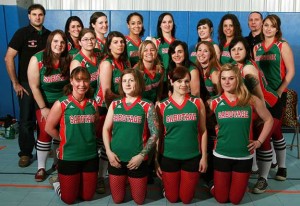
By day, they are massage therapists. Graphic designers. Teachers. Mothers. But when night falls, these women can be found rink-side, assuming colorful pseudonyms like Rinko Starr and Anita Chainsaw, lacing up their roller skates, and duking it out in the dog-eat-dog world of women’s roller derby. They are the CT RollerGirls, self-proclaimed daughters of the American derby revolution, and Connecticut’s first and only female flat-track roller derby league.
But this clearly isn’t the roller derby of the 1960s and early 70s, a televised “entertainment sport” comparable to professional wrestling, and often resulting in on-screen brawls between skaters. Nor is it the scripted story of a misfit’s derby paradise, as depicted in the Drew Barrymore production Whip It! starring Ellen Page. This incarnation of roller derby has an entirely different flavor.
The recent revival comes as a kind of revolution. It is female empowerment on wheels, a kind of third-wave feminism that is inspiring everyday women from all walks of life to throw on a pair of knee pads—and perhaps a glittery tutu—and roll out into jam formation.
To the untrained eye, the game is total chaos. It is a blur of flailing limbs, pounding music, and slippery spills. Learning how to fall is a must. Though players wear helmets, mouthguards, and wrist, elbow, and knee pads, broken bones and bruises are harsh realities. Parker Poison, a member of the league’s All-star travel team known as the Stepford Sabotage, points out, “No one goes out there to hurt each other and we all try to play the sport as clean as possible.” Yet, out on the track, competitive spirits reign. Excitement is palpable, adrenaline is pumping, and animal instinct takes over.
Five players from each team will make their way into the rink to begin the first jam. There will be several two-minute “jams” within two thirty-minute periods. The girls form a pack made up of blockers and pivots of both teams. One “jammer” from each team lines up several paces behind the pack. When, the first whistle sounds, the pack begins to skate, with each player maneuvering to get the best position possible in the cluster. A second shrill whistle, and the two jammers are off. It is their job to weave in and out of the blockers and pivots, racing to be the first jammer to fight through the pack. Teammates within the pack try to clear the way for their jammer, while simultaneously blocking the opposing jammer from making her way to the front. Once the jammers make their way past the opposing pack, they race around the rink, attempting to lap as many members of the opposing team as possible. The more players they pass, the more points their teams earn.
“Roller derby allows women to be all of those things that women are told they can’t be all at once: smart, sexy, and athletic,” says Poison.
But dynamism, in this case, is a good thing. “This sport is new, and there is no preconceived notion of what the ideal body is for roller derby,” Poison says. “Some of the most amazing derby skaters do not have what is normally considered an athletic body type. But with our sport, there is a place for everyone to excel regardless of their body.”
That’s not to say that the Connecticut Rollergirls don’t train hard at their sport. Stepford Sabotage, practices three times a week for two hours and finished ninth overall at Eastern Regionals in 2009. And team members train off of their skates, working with personal trainers to boost power and agility. “Most of [our women] work full-time while balancing family,” says one Stepford Sabotage skater who rolls under the pseudonym Sassin Assassin, “and they still skate six hours a week.”
There is a movement to replace the cacophony of brightly colored knee-highs, hot pink fishnets, or glitzy mini-skirts with standardized uniforms; and many players have traded in their witty aliases—Eleanor Bruisevelt, Murphy’s Outlaw, and Violet Riot, to name a few—for their real names. But watching the girls skate around the track elbowing their competition out of the way, it is hard to believe that any amount of standardization could muffle these women’s spunk.


